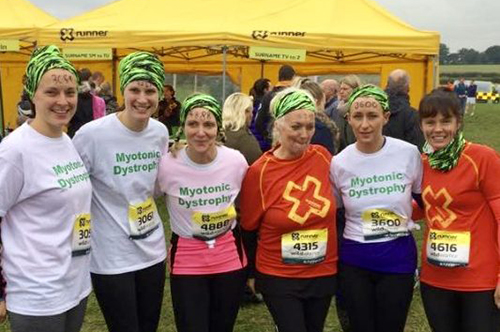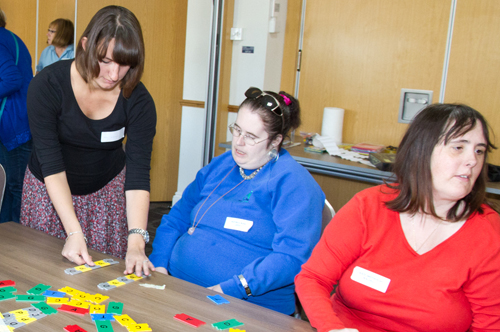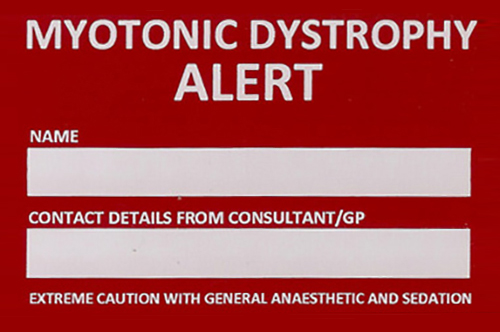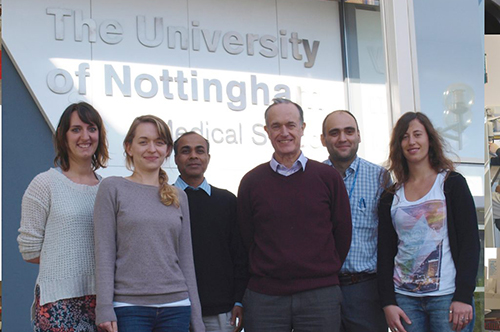
Get involved
We welcome new members and new ideas
Read MoreAmniocentesis
a method of prenatal diagnosis at 15 weeks in which a fluid sample is removed from the womb and grown in tissue culture; it takes another 2-3 weeks for results; a fetus can be tested for genetic diseases this way
Ankle Foot Orthosis (AFO)
an apparatus used to support, align, prevent, or correct deformities or to improve the function of the ankle and foot.
Anticipation
the tendency in certain genetic disorders — like myotonic dystrophy — for individuals in successive generations to present with symptoms at an earlier age and/or with more severe manifesations; often observed in disorders resulting from the expression of a trinucleotide repeat mutation that tends to increase in size and have a more significant effect when passed from one generation to the next.
Anticholinesterases
(example: Neostigmine) one of the drugs that myotonic dystrophy patients should avoid; can adversely affect diameter of blood vessels, function of the intestines, and part of the nervous system that controls smooth muscle, heart muscle and gland cells
Apnea
periodic absence of breathing while sleeping
Arrhythmia
an irregular heart beat
Aspiration pneumonia
a serious form of pneumonia resulting from inhalation of foreign material, usually food particles or vomit, into the bronchi
Asymptomatic
without symptoms, at least in the mind of the person himself
Atrial fibrillation
the normal rhythmical contractions of the cardiac atria (or upper chambers of the heart) are replaced by rapid irregular twitchings of the muscular wall
Attention Deficit Hyperactivity Disorder
a behavior disorder originating in childhood in which the essential features are signs of developmentally inappropriate inattention, impulsivity and hyperactivity. Although most individuals have symptoms of both inattention and hyperactivity-impulsivity, one or the other pattern may be predominant. The disorder is more frequent in males than females. Onset is in childhood. Symptoms often attenuate during late adolesence, although a minority experiences the full complement of symptoms into mid-adulthood.
Autosomal dominant
a pattern of inheritance in which if one parent has a mutated gene, each offspring has a 50% chance of inheriting it
Barium swallow test
a test in which a patient swallows a thick white substance and the swallowing process is filmed to detect possible abnormalities
Blepheroplasty
any operation for the correction of a defect in the eyelids
Bradyarrhythmia
any disturbance of the heart’s rhythm resulting in a rate of under 60 beats per minute
Bulbar weakness presence of weakness in the tongue, lips, palate, pharynx and larynx
Cataracts
a film that can form in the eye and cause complete or partial opacity of the ocular lens, or blurry vision; in myotonic dystrophy patients, often posterior subcapsular iridescent cataracts form; they are sometimes referred to as Christmas-tree cataracts
Cardiac conduction
the electrical impulses that cause the heart to beat
Cardiomyopathy
damage to the heart muscle that decreases its ability to pump blood effectively
Cardiotoxicity
substance that is harmful to the heart
CCTG
the abbreviation for “cytosine, cytosine, thymidine, guanine”, the chemicals in the DNA that cause myotonic dystrophy type-2 (on chromosome 3) when they are created in repeats greater than the normal number
Chorionic villus sampling (CVS)
a method of prenatal diagnosis at around 10 weeks into the pregnancy; a biopsy in which a piece of membrane around the embryo is removed using a needle through the abdomen or vagina; results in 1-2 weeks
Chromosome
one of the bodies (normally 23 pairs) located in the nucleus of a cell that hosts the genes
Cisapride
(example: propulsid) a prokinetic drug that should be avoided by individuals with myotonic dystrophy
Club foot
an inversion of the foot in which only the outer side of the sole touches the ground; also called talipes equinovarus
CNS
abbreviaton for central nervous system; brain
Cognitive problems
difficulties with thinking, learning and memory
Conduction defects
problems with the electrical impulses that regulate the heart beat
Congenital
present at birth
Contraction
on FAQs page, referring to genetic mutation, or abnormailty, becoming smaller as it passes to offspring; happens rarely in myotonic dystrophy
Contractures
permanent tightening of muscles causing abnormal joint rigidity
CPAP
acronym for continuous positive airway pressure; a device that delivers air to the nose for easier breathing; often used at night for those with sleep apnea
Creatine Kinase (CK) levels
an important enzyme in muscle contraction
CTG
the abbreviation for “cytosine, thymidine, guanine”, the 3 chemicals in the DNA that cause myotonic dystrophy type-1 (on chromosome 19) when they sputter beyond the normal 5-37 repeats found along the rung-looking parts in the double helix that resembles a gracefully twisted ladder
Degenerative
deteriorating, getting worse
Depolarizing neuromuscular blocking agents
(example: suxamethonium) drugs causing skeletal muscle paralysis
Distal
situated away from the trunk of the body, at the end of the limbs toward the feet and hands
DM1
the abbreviation for the Latin name for myotonic dystrophy (dystrophia myotonica) type 1, the more severe form of myotonic dystrophy with the mutation found on chromosome 19
DM2
the abbreviation for the Latin name for myotonic dystrophy (dystrophia myotonica) type 2, with the mutation found on chromosome 3
DM3
abbreviation given to suspected disease with manifestations similar to DM1 and DM2 but whose gene location has not yet been determined
DMPK
the abbreviation for the myotonic dystrophy gene, the Myotonic Dystrophy Protein Kinase gene that causes DM1; it is located on chromosome 19
Double helix
two strands of DNA held together by hydrogen bonds; when enlarged it resembles a tiny ladder (with many rungs) that has been gracefully twisted; it is along these rungs that the chemical repeats stutter beyond their normal number and cause the mutation, or change, in the gene that causes myotonic dystrophy
Dominant inheritance
as in myotonic dystrophy, the expression of a gene where if one parent carries the mutated gene, the children have a 50% chance of getting it
Dysphagia
difficulty swallowing
Dysphasia
difficulty speaking
Dyspnea
shortness of breath
Dystrophy
an inherited muscle disorder in which the muscles become weaker
Ectopic
occuring in the wrong place in the body, such as the development of an impregnated egg outside the cavity of the uterus; or, a cardiac beat originating elsewhere other than at the sinoatrial node
EDS
acronym for excessive daytime sleepiness
EKG or ECG
electrocardiogram, a test that prints out a graphic record of a person’s heart beat
Endocrine system
the body system that secretes hormones that allow the body perform many of its functions
Epidemiology
the study of the distribution of health-related states (for a specific disease, like myotonic dystrophy) or events in specified populations
Esophagus
the portion of the digestive canal between the pharynx and stomach
Expansion
on FAQ’s page, referring to enlargement of the myotonic dystrophy genetic mutation, or abnormality, as it passes to offspring; also refers to the enlargement of mutations within a given organ or system over the life of an affected individual (see somatic mosaicism); happens often in myotonic dystrophy
Foot drop
partial or total inability to dorsiflex (turn upward) the foot
Gait
manner of walking
Gastroenterologist
a doctor focusing on the function and disorders of the stomach, intestines and assorted organs that are often referred to as the GI tract
Gene
a functional unit of heredity (like eye and hair color, height, among many other characteristics including inherited diseases) that occupies a specific place on a chromosome; it is capable of reproducing itself at each cell division and directs the formation of an enzyme or protein
Genetic
of or pertaining to genes; inherited
Genetic counseling
a meeting with a medical professional, often a geneticist, to learn how a possible inherited disease can affect you, and how you can choose to avoid passing it to your offspring if you so choose
Genomic background
referring to the complete set of genes inherited from one’s parents
Genotypes
the sum total of the genetic material transmitted from a person’s parents
GI tract
bodily system referrring to the stomach, intestines and related organs
Gonadal (or testicular) atrophy in men
a medical condition in which the male reproductive organs (the testes) diminish in size and fail to function
G-Tube
implanted feeding tube to supply sustenance when person is unable to safely swallow on his own impotence
Haplotype analylsis
molecular genetic testing to identify a set of closely linked segments of DNA
Heterotropia
inability of one eye to attain binocular vision with the other because of imbalance of the muscles of the eyeball–called also strabismus, squint.
Hydramnios
excessive amniotic fluid build-up during pregnancy
Hyperkalemia
a greater than normal concentration of potassium ions in the circulating blood
Hyperostosis
excessive growth of bony tissue
Hypersomnia
excessive daytime sleepiness
Hypertrophy
general increase in bulk or a part of an organ
Hypothermia a body temperature significantly below 98.6
Hypotonia
low muscle tone causing floppiness, as in a child with the congenital form of myotonic dystrophy
Implanted Cardioconverter Defibrillator (ICD)
a cardiac device implanted in the chest; a combination pace-maker and defibrillator designed to regulate the heart beat, to keep it from beating too fast or too slow
Impulse inhibition
the inability to control one’s impulses
In vitro fertilization
eggs are obtained from the female after her ovaries have been stimulated with infertility drugs. While under sedation and with the use of ultrasound guidance, a needle is inserted into the ovaries and eggs are aspirated. These eggs are then fertilized in the laboratory (in-vitro) with the partner’s sperm and the developing embryos are cultured from three to six days.
Incentive spirometry
a breathing device to help exercise breathing muscles and help maximize lung capacity
Induction drugs
drugs used to “knock a patient out” prior to surgery and certain other procedures
Insulin resistance
diminished effectiveness of insulin in lowering blood sugar levels
Intercostal muscles
muscles between the ribs
Intubation
the insertion of a tube into the lungs to provide pulmonary ventilation, or to assist with breathing
Motility
the power of spontaneous movement
Multi-systemic disorder
a disease that can affect many different organs and systems in the body
Mutation
as used on this website, a change in the normal chemistry of a gene
Myotonia
the inability of contracted muscles to relax on command; or, a special kind of muscle stiffness
Myopathy
muscle weakness
NICU
neonatal (new born) intensive care unit
Opiates
any preparation or derivative of opium
Oro-
referring to the mouth
Oropharyngeal muscle weakness
reduced strength in the upper expanded portion of the digestive tube, between the esophagus below the mouth and nasal cavities above and in front
PCR – polymerase chain reaction
a procedure that produces millions of copies of a short segment of DNA; the amplified product, doubled each cycle for 30 more cycles, can then be subjected to further testing; it is a common procedure in molecular genetic testing in order to generate enough DNA to perform the test; in individuals suspected of having myotonic dystrophy, it can be used to determine the number of trinucleptide repeats in the DMPK gene on the 19th chromosome.
PGD
abbreviation for preimplantation genetic diagnosis achieved through in vitro fertilization where analysis of embryos is done prior to being implanted by a doctor into the uterus of a woman
Pace-maker
an implanted heart device to correct a very slow or irregular heart beat
Perioperative
around the time of surgery
Pharynx
the upper expanded portion of the digestive tube, between the esophagus below the mouth and nasal cavities above and in front
Phenotype
the observable signs, symptoms and other aspects of a person’s outward appearance and behavior
Pilomatrixoma
benign skin tumors under the skin; associated with hair follicles
Placenta
organ formed inside the lining of the womb that provides nourishment for fetus and elimination of its waste products
Placenta previa
condition in pregnancy in which the placenta (see definition) is implanted in lower segment of womb close to the internal opening of the cervix, or sometimes completely covering that internal opening
Polyhydramnios
excessive amniotic fluid build-up during pregnancy
Postoperative apnea
absence of breathing after surgery
Postpartum hemorrhage
heavy bleeding from the birth canal after vaginal delivery of a baby
Preimplantation genetic diagnosis (in vitro fertilization)
procedure in which eggs are retrieved from woman under sedation, fertilization of egg with sperm in a laboratory, testing for genetic abnormalities and healthy, fertilized eggs implanted by a doctor into the woman’s womb
Pre-mutation
the presence of slightly more than the normal number of nucleotide repeats in the genetic mutation, e.g. in DM1, somewhere between 38 and 50; CTG repeats; the person exhibits no symptoms but are at risk of having affected children
Prenatal diagnosis
a process of determining whether a child in the womb has a specific inherited disorder
Prognosis
forecast of the probable course and outcome of a disease
PROMM
abbreviation for proximal myotonic myopathy or DM2
Proximal
in medicine, it refers to a part of the body that is nearest to the trunk of the body, such as thighs and upper arms
Ptosis
droopy eye-lids due to muscle atrophy
Pulse oximetry
a test to measure oxygen levels in the blood
Respiratory function test
a test that measures the amount of air a person can blow out
Smooth muscles
muscles that are part of or surround internal organs, as along the gastrointestinal tract
Somatic
physical
Somatic mosaicism
in DM1, the presence of different numbers of CTG repeats (the abnormality) found in different organs and systems within the same person; in DM2, the presence of different numbers of CCTG repeats found in different organs and systems within the same person
Sonogram
an image created by ultrasound obtained by a computerized instrument; it can reveal internal parts of the body, such as thyroid gland or fetus in utero
Steinert’s disease
the first name given to myotonic dystrophy when it was identified as a disease by Dr. Hans Steinert of Germany in 1909
Strabismus
inability of one eye to attain binocular vision with the other because of imbalance of the muscles of the eyeball–called also heterotropia, squint.
Sudden heart block
a condition of the heart in which the passage of an electrical impulse is arrested, wholly or in part, temporarily or permanently
Tachyarrhythmia
very rapid heart beats
Talipes equinovarus
an inversion of the foot in which only the outer side of the sole touches the ground; also called club foot
Testicular (or gonadal) atrophy in men
impotence
Tetranucleotide repeats
as related to myotonic dystrophy, the series of 4 chemicals (abbreviated CCTG and found in the DNA of the ZNF9 gene, on the 3rd chromosome) that repeats itself more times than normal and causes myotonic dystrophy type-2
Tracheostomy tube
a curved tube inserted into the windpipe to keep the opening free for breathing when patient has difficulty breathing on his own
Tracheotomy
the implantation of a tube into the trachea to assist patient with breathing; inserted through neck just below the thyroid gland
Trinucleotide repeats
as related to myotonic dystrophy, the series of 3 chemicals (abbreviated CTG and found in the DNA of the DMPK gene, on the 19th chromosome) that repeats itself more times than normal and causes myotonic dystrophy type 1
ZNF9
the mutated gene on chromosome 3 that causes DM2; sometimes called the zinc finger gene

We welcome new members and new ideas
Read More
Myotonic Dystrophy is a condition affecting 1 in 8000 adults
Read More
Offering friendship and support to all those affected
Read More
Keep up to date with research in this field
Read More